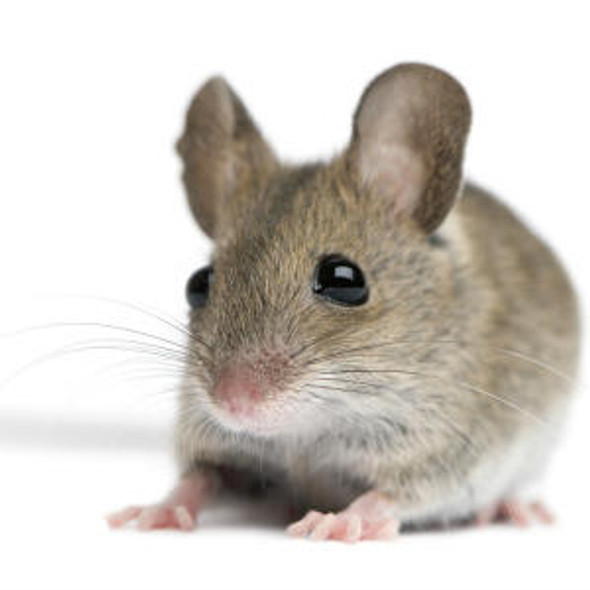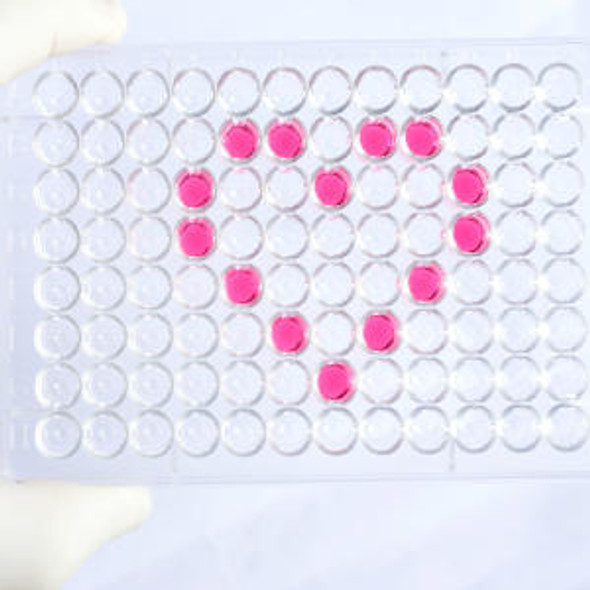Rat eNOS / Nitric oxide synthase, endothelial ELISA Kit
- SKU:
- RTFI00087
- Product Type:
- ELISA Kit
- Size:
- 96 Assays
- Uniprot:
- Q62600
- Sensitivity:
- 9.375pg/ml
- Range:
- 15.625-1000pg/ml
- ELISA Type:
- Sandwich ELISA, Double Antibody
- Synonyms:
- NOS3, eNOS, Constitutive NOS, ECNOS, endothelial, Endothelial NOS, eNOS, cNOS, nitric oxide synthase 3, endothelial cell
- Reactivity:
- Rat
Description
| Product Name: | Rat NOS3/eNOS (Nitric Oxide Synthase 3, Endothelial) ELISA Kit |
| Product Code: | RTFI00087 |
| Size: | 96 Assays |
| Target: | Rat NOS3/eNOS |
| Alias: | NOS3, eNOS, Constitutive NOS, ECNOS, endothelial, Endothelial NOS, eNOS, cNOS, nitric oxide synthase 3, endothelial cell |
| Reactivity: | Rat |
| Detection Method: | Sandwich ELISA, Double Antibody |
| Sensitivity: | 9.375pg/ml |
| Range: | 15.625-1000pg/ml |
| Storage: | 4°C for 6 months |
| Note: | For Research Use Only |
| Recovery: | Matrices listed below were spiked with certain level of Rat NOS3/eNOS and the recovery rates were calculated by comparing the measured value to the expected amount of Rat NOS3/eNOS in samples. | ||||||||||||||||
| |||||||||||||||||
| Linearity: | The linearity of the kit was assayed by testing samples spiked with appropriate concentration of Rat NOS3/eNOS and their serial dilutions. The results were demonstrated by the percentage of calculated concentration to the expected. | ||||||||||||||||
| |||||||||||||||||
| Intra-Assay: | CV <8% | ||||||||||||||||
| Inter-Assay: | CV <10% |
| Uniprot: | Q62600 |
| UniProt Protein Function: | eNOS: endothelial constitutive nitric oxide synthase. Synthesizes nitric oxide (NO) from arginine and oxygen, which is implicated in vascular smooth muscle relaxation through a cGMP-mediated signal transduction pathway. NO mediates vascular endothelial growth factor (VEGF)-induced angiogenesis in coronary vessels and promotes blood clotting through the activation of platelets. Induced in humans by caloric restriction. Stimulated by calcium/calmodulin. Inhibited by NOSIP and NOSTRIN. |
| UniProt Protein Details: | Protein type:EC 1.14.13.39; Oxidoreductase; Amino Acid Metabolism - arginine and proline Cellular Component: apical part of cell; caveola; cytoplasm; cytoskeleton; cytosol; Golgi apparatus; lipid raft; mitochondrion; nucleolus; nucleus; plasma membrane; sarcolemma; vesicle membrane Molecular Function:actin binding; actin monomer binding; beta-catenin binding; cadherin binding; calmodulin binding; FAD binding; FMN binding; heme binding; Hsp90 protein binding; iron ion binding; NADP binding; nitric-oxide synthase activity; nitric-oxide synthase binding; protein binding Biological Process: aging; angiogenesis; arginine catabolic process; blood vessel remodeling; endothelial cell migration; female pregnancy; in utero embryonic development; lipopolysaccharide-mediated signaling pathway; lung development; negative regulation of blood pressure; negative regulation of calcium ion transport; negative regulation of cell proliferation; negative regulation of hydrolase activity; negative regulation of muscle hyperplasia; negative regulation of potassium ion transport; negative regulation of smooth muscle cell proliferation; nitric oxide biosynthetic process; nitric oxide mediated signal transduction; ovulation from ovarian follicle; positive regulation of angiogenesis; positive regulation of apoptosis; positive regulation of guanylate cyclase activity; positive regulation of vasodilation; regulation of blood vessel size; regulation of sodium ion transport; regulation of systemic arterial blood pressure by endothelin; regulation of the force of heart contraction by chemical signal; removal of superoxide radicals; response to activity; response to amino acid stimulus; response to axon injury; response to corticosterone stimulus; response to cytokine stimulus; response to drug; response to estradiol stimulus; response to ethanol; response to fructose stimulus; response to hyperoxia; response to hypoxia; response to lead ion; response to lipopolysaccharide; response to lipoprotein stimulus; response to mechanical stimulus; response to metal ion; response to organic cyclic substance; response to peptide hormone stimulus; retina development in camera-type eye; signal transduction; smooth muscle hyperplasia |
| NCBI Summary: | enzyme that synthesizes Nitric oxide from L-arginine [RGD, Feb 2006] |
| UniProt Code: | Q62600 |
| NCBI GenInfo Identifier: | 46402488 |
| NCBI Gene ID: | 24600 |
| NCBI Accession: | NP_068610.1 |
| UniProt Secondary Accession: | Q62600,O88672, O89041, Q62734, Q68GV6, Q75NE4, |
| UniProt Related Accession: | Q62600 |
| Molecular Weight: | 133,290 Da |
| NCBI Full Name: | nitric oxide synthase, endothelial |
| NCBI Synonym Full Names: | nitric oxide synthase 3 |
| NCBI Official Symbol: | Nos3 |
| NCBI Official Synonym Symbols: | eNos |
| NCBI Protein Information: | nitric oxide synthase, endothelial |
| UniProt Protein Name: | Nitric oxide synthase, endothelial |
| UniProt Synonym Protein Names: | Constitutive NOS; cNOS; EC-NOS; Endothelial NOS; eNOS; NOS type III; NOSIII |
| Protein Family: | Nitric oxide synthase |
| UniProt Gene Name: | Nos3 |
| UniProt Entry Name: | NOS3_RAT |
| Step | Procedure |
| 1. | Set standard, test sample and control (zero) wells on the pre-coated plate respectively, and then, record their positions. It is recommended to measure each standard and sample in duplicate. Wash plate 2 times before adding standard, sample and control (zero) wells! |
| 2. | Aliquot 0.1ml standard solutions into the standard wells. |
| 3. | Add 0.1 ml of Sample / Standard dilution buffer into the control (zero) well. |
| 4. | Add 0.1 ml of properly diluted sample ( Human serum, plasma, tissue homogenates and other biological fluids.) into test sample wells. |
| 5. | Seal the plate with a cover and incubate at 37°C for 90 min. |
| 6. | Remove the cover and discard the plate content, clap the plate on the absorbent filter papers or other absorbent material. Do NOT let the wells completely dry at any time. Wash plate X2. |
| 7. | Add 0.1 ml of Biotin- detection antibody working solution into the above wells (standard, test sample & zero wells). Add the solution at the bottom of each well without touching the side wall. |
| 8. | Seal the plate with a cover and incubate at 37°C for 60 min. |
| 9. | Remove the cover, and wash plate 3 times with Wash buffer. Let wash buffer rest in wells for 1 min between each wash. |
| 10. | Add 0.1 ml of SABC working solution into each well, cover the plate and incubate at 37°C for 30 min. |
| 11. | Remove the cover and wash plate 5 times with Wash buffer, and each time let the wash buffer stay in the wells for 1-2 min. |
| 12. | Add 90 µL of TMB substrate into each well, cover the plate and incubate at 37°C in dark within 10-20 min. (Note: This incubation time is for reference use only, the optimal time should be determined by end user.) And the shades of blue can be seen in the first 3-4 wells (with most concentrated standard solutions), the other wells show no obvious color. |
| 13. | Add 50 µL of Stop solution into each well and mix thoroughly. The color changes into yellow immediately. |
| 14. | Read the O.D. absorbance at 450 nm in a microplate reader immediately after adding the stop solution. |
When carrying out an ELISA assay it is important to prepare your samples in order to achieve the best possible results. Below we have a list of procedures for the preparation of samples for different sample types.
| Sample Type | Protocol |
| Serum: | If using serum separator tubes, allow samples to clot for 30 minutes at room temperature. Centrifuge for 10 minutes at 1,000x g. Collect the serum fraction and assay promptly or aliquot and store the samples at -80°C. Avoid multiple freeze-thaw cycles. If serum separator tubes are not being used, allow samples to clotovernight at 2-8°C. Centrifuge for 10 minutes at 1,000x g. Removeserum and assay promptly or aliquot and store the samples at-80°C. Avoid multiple freeze-thaw cycles. |
| Plasma: | Collect plasma using EDTA or heparin as an anti-coagulant. Centrifuge samples at 4°C for 15 mins at 1000 — g within 30 mins of collection. Collect the plasma fraction and assay promptly or aliquot and store the samples at -80°C. Avoid multiple freeze-thaw cycles.Note: Over haemolysed samples are not suitable for use with this kit. |
| Urine & Cerebrospinal Fluid: | Collect the urine (mid-stream) in a sterile container, centrifuge for 20 mins at 2000-3000 rpm. Remove supernatant and assay immediately. If any precipitation is detected, repeat the centrifugation step. A similar protocol can be used for cerebrospinal fluid. |
| Cell Culture Supernatant: | Collect the cell culture media by pipette, followed by centrifugation at 4°C for 20 mins at 1500 rpm. Collect the clear supernatant and assay immediately. |
| Cell Lysates: | Solubilize cells in lysis buffer and allow to sit on ice for 30 minutes. Centrifuge tubes at 14,000 x g for 5 minutes to remove insoluble material. Aliquot the supernatant into a new tube and discard the remaining whole cell extract. Quantify total protein concentration using a total protein assay. Assay immediately or aliquot and store at ≤ -20°C. |
| Tissue Homogenates: | The preparation of tissue homogenates will vary depending upon tissue type. Rinse tissue with 1X PBS to remove excess blood & homogenizein 20ml of 1X PBS (including protease inhibitors) and store overnight at ≤ -20°C. Two freeze-thaw cycles are required to break the cell membranes. To further disrupt the cell membranes you can sonicate the samples. Centrifuge homogenates for 5 mins at 5000xg. Remove the supernatant and assay immediately or aliquot and store at -20°C or-80°C. |
| Tissue Lysates: | Rinse tissue with PBS, cut into 1-2 mm pieces, and homogenize with a tissue homogenizer in PBS. Add an equal volume of RIPA buffer containing protease inhibitors and lyse tissues at room temperature for 30 minutes with gentle agitation. Centrifuge to remove debris. Quantify total protein concentration using a total protein assay. Assay immediately or aliquot and store at ≤ -20 °C. |
| Breast Milk: | Collect milk samples and centrifuge at 10,000 x g for 60 min at 4°C. Aliquot the supernatant and assay. For long term use, store samples at -80°C. Minimize freeze/thaw cycles. |










